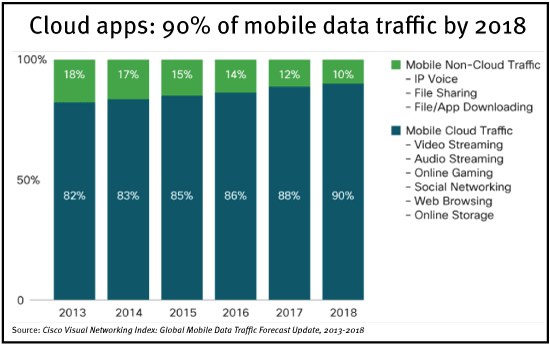
We can’t afford to ignore the myriad of mobile devices and apps currently saturating our attention and wireless connections.
In my last post, I laid out some of the industry’s eye-popping numbers. This time, I’m offering up just one graphic (from Cisco’s recent Global Mobile Data Traffic Forecast Update ) showing why you must upgrade your network infrastructure. Pronto.

Meeting transformational mobile technologies…
A couple technologies are changing the bare-minimum requirements of wireless connectivity:
- Gigabit wi-fi – emerging wi-fi standards (e.g., 802.11ac/11ad/11aq/11ah) will increase performance into 1.3 Gbps territory and also boost speeds for devices using older standards.This makes it viable, if not necessary, to replace legacy voice systems with unified communications (UC) and to deliver bandwidth-intensive applications such as video and telemetry. Eventually wi-fi will exceed gigabit speeds, requiring network upgrades to support faster backhaul for wireless access points.
- LTE and LTE-A – by improving spectral efficiency, cellular technologies LTE (Long Term Evolution) and LTE-A (LTE Advanced) will reach theoretical peak downlink speeds of up to 1 Gbps while reducing latency, thus boosting bandwidth.
…with new enterprise capabilities
To adapt your enterprise network to this dynamic wireless world, you’ll need to include mobile devices and apps in a single, unified communications and collaboration infrastructure that smoothly integrates voice, video, and data while maintaining wireless network security.
What you’ll need to do this depends, of course, on the particulars of your business and your existing network — but odds are that it’ll involve some or all of these capabilities:
- Mobile unified communications providing visibility into wireless traffic and communicating directly with UC systems, enabling reliable, high-quality voice and video — and giving you an end-to-end view of corporate communications for the first time.
- Cloud wi-fi. The hassles of handling wi-fi network connectivity across multiple locations can be simplified by services that automate and orchestrate corporate wi-fi provisioning and management. The cost and efficiency improvements can actually change the ways you connect your distributed locations.
- Mobile device management tools are evolving to include security and app management capabilities as well as features of enterprise file synchronization and sharing.
- Application performance monitoring (APM) tools gather mobile metrics gathered by application performance monitoring (APM) tools that can help you anticipate and minimize performance bottlenecks. APM lets you know which devices and OSs are in use, gives you visibility into app behavior, and monitors user actions to determine which app features are successfully utilized.
- Software-defined networks (SDN) adapt in real time to the traffic and applications running on it. Software-defined networks provide visibility as well as an ability to optimize delivery of mobile apps, thus improving employee productivity and customer usability.
My advice: find a trusted technology advisor who can provide an independent assessment of your current network and suggest a range of future-focused wireless network options.

